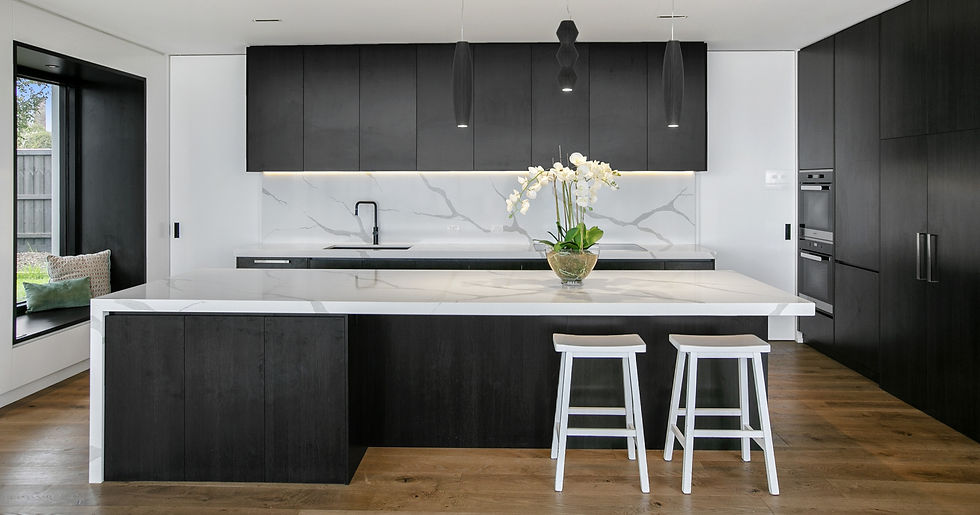Living the dream
- Ruth, Photography by BWRM
- May 6, 2020
- 3 min read
Updated: Sep 14, 2020
As our living spaces are often for both private family use and friends 'consumption', the challenge is to strike the right balance between personal comfort and practicality while having the desire to make a strong design statement.
Introduce variety and interest into a living space by using different colours, patterns, textures and furniture. Vary the heights with table lamps, floor lamps, vases and other decorative pieces. If the room is very neutral, you can introduce colour or pattern with adding a rug or a bold painting.
Cushions are also a great way to bring in colour and texture in a more budget friendly way.

Make a long lasting first impression, don't overlook the entrance to your house. The entrance or hallway is important because it sets the scene for what's to come. It is not hard to make a good first impression on visitors. Dress up your entrance with potted plants or paint your front door in a striking colour, whatever you choose to do make a statement.
Remember a hall is not just a space you pass through. Think of it as a gallery... You don't spend much time there, so you could safely choose a bolder colour than you would for an everyday room, make sure it is warm and welcoming. This is your opportunity to show your style, add a rug and a great light fitting, hang a mad painting because you won't be forced to look at it for long and it will create that instant wow-factor. Emphasise the floor if the ceiling is low or draw the eye to a high ceiling with a knock-out light fitting.
To create extra space you can open up hallways. Living and dining rooms can be easily enlarged by removing walls and opening them to a hall or passageway. Strategically placed furniture will then define the traffic area and create different zones, yet you won't intrude on the feeling of space.
One of the benefits of open-plan living has led to a less formal approach to design and decoration

but you can still clearly define each space through furniture layout or the use of decorative elements such as rugs and screens. In many open-plan designs, the dining, lounge and kitchen are part of one large space. The cook in the family can talk to guests in the lounge area while preparing a meal and you can keep an eye on what your children are watching on tv.
A large rug placed under the dining table will anchor the table setting and give the area a sense of differentiation, while a well placed screen can make the living area seem cosier at night. A screen is a useful decorative asset in it's own right, it will change the focus of a room.
Save the best views for the living area, capture your lovely garden or bay vista with floor to ceiling windows. A pretty garden deserves to be seen from inside the house, so replace your small windows with bi-folds, a bay window or french doors.

Don't forget the benefits of creating indoor-outdoor living spaces. To successfully integrate interior and exterior spaces, you need to blur the physical boundaries that seperate them. This can be achieved in various ways, large glass doors that open to create the illusion of one interconnected space or by repetition of materials, colours and finishes. New homes designs are clearly reflecting this trend with interior living rooms positioned at the back of the home where they open out through sliding doors to covered areas. Another options is to construct a seperate outdoor room, a permanent structure like a poolside pavilion, where you create space for lounging, dining and maybe even for cooking. Add lighting and a sound system and you can enjoy some quality alfresco living in absolute comfort.

If you are lucky enough to have a house with two living rooms, you can have some fun with the formal space, make it as elegant as you like. It's mainly used by adults in the family for entertaining, so have those special pieces you wouldn't risk putting in a high traffic family room. Whatever look you choose, it helps if the room has a focal point or something, like a fireplace, to draw the eye. You can build around a special painting, a table topped by a grand mirror or a view of the garden. Many of us don't even realise we have a collection of china, glass vases or even treasured photographs that can make a stunning display when grouped together as a vignette, a story of treasures.
Whether the room is for formal or informal living, when it comes to hanging paintings or prints, don't put them up around the ceiling. The experts say the centre of a painting should be at eye level.
Hope these bright ideas give you the right guidance to create your dream living space. Discover your style and have fun with it!
Ruth x




Comments